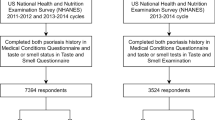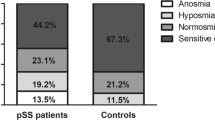Abstract
It is well known that psoriasis is not only limited to skin, but a systemic autoimmune disease with various comorbidities. Olfactory dysfunction, one of as a common but lesser known symptom of patients with autoimmune diseases, often presents with smell loss. The aim of this study was to assess the olfactory functions in patients with psoriasis and to compare with healthy controls. A total of 50 patients with psoriasis and 43 control subjects were included to the study. The clinical severity of psoriasis was calculated by psoriasis area and severity index (PASI). Patients were classified into two groups according to PASI score as mild (PASI ≤10) and moderate–severe (PASI >10). Olfactory function was evaluated with “Sniffin’Sticks” test. Total test scores (max. 48 points) of threshold, discrimination, and identification (TDI) were classified as normal olfaction = normosmia (>30.3 points), decreased olfaction = hyposmia (16.5–30.3 points) and loss of olfaction = anosmia (<16.5 points). Psoriasis patients had significantly lower smell scores compared with healthy controls (p < 0.001). Of the 50 psoriasis patients, 40 (80 %) were hyposmic. We found negative correlation between TDI and PASI (r = −0.34, p = 0.014). The TDI scores of the patients with moderate–severe psoriasis (PASI score >10) were found to be significantly lower than the patients with mild psoriasis (PASI ≤10) (p < 0.001). Olfactory dysfunction in patients with psoriasis could be thought as a comorbidity as in other inflammatory disorders. Physicians should be aware of olfactory impairment when evaluating psoriasis patients in their clinical practice.



Similar content being viewed by others
References
Arican O, Aral M, Sasmaz S, Ciragil P (2005) Serum levels of TNF-alpha, IFN-gamma, IL-6, IL-8, IL-12, IL-17, and IL-18 in patients with active psoriasis and correlation with disease severity. Mediators Inflamm 2005:273–279. doi:10.1155/MI.2005.273
Asadullah K, Sterry W, Stephanek K, Jasulaitis D, Leupold M, Audring H, Volk HD, Döcke WD (1998) IL-10 is a key cytokine in psoriasis. Proof of principle by IL-10 therapy: a new therapeutic approach. J Clin Invest 101:783–794
Christophers E (2007) Comorbidities in psoriasis. Clin Dermatol 25:529–534. doi:10.1016/j.clindermatol.2007.08.006
Coimbra S, Oliveira H, Reis F, Belo L, Rocha S, Quintanilha A, Figueiredo A, Teixeira F, Castro E, Rocha-Pereira P, Santos-Silva A (2010) C-reactive protein and leucocyte activation in psoriasis vulgaris according to severity and therapy. J Eur Acad Dermatol Venereol 24:789–796. doi:10.1111/j.1468-3083.2009.03527.x
Fitch E, Harper E, Skorcheva I, Kurtz SE, Blauvelt A (2007) Pathophysiology of psoriasis: recent advances on IL-23 and Th17 cytokines. Curr Rheumatol Rep 9:461–467
Ghoreschi K, Bruck J, Kellerer C, Deng C, Peng H, Rothfuss O, Hussain RZ, Gocke AR, Respa A, Glocova I, Valtcheva N, Alexander E, Feil S, Feil R, Schulze-Osthoff K, Rupec RA, Lovett-Racke AE, Dringen R, Racke MK, Rocken M (2011) Fumarates improve psoriasis and multiple sclerosis by inducing type II dendritic cells. J Exp Med 208:2291–2303. doi:10.1084/jem.20100977
Griffiths CE, Barker JN (2007) Pathogenesis and clinical features of psoriasis. Lancet 370:263–271. doi:10.1016/S0140-6736(07)61128-3
Gülekon A, Adışen E (2008) Psoriasis and co-morbidities. Turkderm 42(Suppl 2):23–25
Henkin RI, Schmidt L, Velicu I (2013) Interleukin 6 in hyposmia. JAMA Otolaryngol Head Neck Surg 139:728–734. doi:10.1001/jamaoto.2013.3392
Hummel T, Kobal G, Gudziol H, Mackay-Sim A (2007) Normative data for the “Sniffin’Sticks” including tests of odor identification, odor discrimination, and olfactory thresholds: an upgrade based on a group of more than 3000 subjects. Eur Arch Otorhinolaryngol 264:237–243
Hummel T, Sekinger B, Wolf SR, Pauli E, Kobal G (1997) ‘Sniffin’ sticks’: olfactory performance assessed by the combined testing of odor identification, odor discrimination and olfactory threshold. Chem Senses 22:39–52
Karabacak E, Aydin E, Ozcan O, Dogan B, Gultepe M, Cosar A, Muftuoglu T (2014) Methylenetetrahydrofolate reductase (MTHFR) 677C> T gene polymorphism as a possible factor for reducing clinical severity of psoriasis. Int J Clin Exp Med 7(3):697–702 (eCollection 2014)
Kobal G, Hummel T, Sekinger B, Barz S, Roscher S, Wolf S (1996) “Sniffin’ sticks”: screening of olfactory performance. Rhinology 34:222–226
Krueger JG, Bowcock A (2005) Psoriasis pathophysiology: current concepts of pathogenesis. Ann Rheum Dis 64(Suppl 2):ii30–ii36. doi:10.1136/ard.2004.031120
Lowes MA, Bowcock AM, Krueger JG (2007) Pathogenesis and therapy of psoriasis. Nature 445:866–873. doi:10.1038/nature05663
Lutterotti A, Vedovello M, Reindl M, Ehling R, DiPauli F, Kuenz B, Gneiss C, Deisenhammer F, Berger T (2011) Olfactory threshold is impaired in early, active multiple sclerosis. Mult Scler 17:964–969
Naldi L (2010) Scoring and monitoring the severity of psoriasis. What is the preferred method? What is the ideal method? Is PASI passe? facts and controversies. Clin Dermatol 28:67–72. doi:10.1016/j.clindermatol.2009.03.001
Neuner P, Urbanski A, Trautinger F, Moller A, Kirnbauer R, Kapp A, Schopf E, Schwarz T, Luger TA (1991) Increased IL-6 production by monocytes and keratinocytes in patients with psoriasis. J Invest Dermatol 97:27–33
Perricone C, Shoenfeld N, Agmon-Levin N, de Carolis C, Perricone R, Shoenfeld Y (2013) Smell and autoimmunity: a comprehensive review. Clin Rev Allergy Immunol 45:87–96. doi:10.1007/s12016-012-8343-x
Pozharskaya T, Lane AP (2013) Interferon gamma causes olfactory dysfunction without concomitant neuroepithelial damage. Int Forum Allergy Rhinol 3:861–865. doi:10.1002/alr.21226
Proft F, Steinbach S, Dechant C, Witt M, Reindl C, Schulz S, Vielhauer V, Hilge R, Laubender RP, Manger K, Nusslein H, Wendler J, Schuch F, Schulze-Koops H, Grunke M (2014) Gustatory and olfactory function in patients with granulomatosis with polyangiitis (Wegener’s). Scand J Rheumatol 43:512–518. doi:10.3109/03009742.2014.915056
Rifaioğlu EN, Özarmağan G (2016) Clinical and demographic characteristics of 626 patients with moderate and severe psoriasis. J Clin Anal Med 7:18–23. doi:10.4328/JCAM.2413
Rocha-Pereira P, Santos-Silva A, Rebelo I, Figueiredo A, Quintanilha A, Teixeira F (2004) The inflammatory response in mild and in severe psoriasis. Br J Dermatol 150:917–928. doi:10.1111/j.1365-2133.2004.05984.x
Sen BB, Rifaioglu EN, Ekiz O, Inan MU, Sen T, Sen N (2014) Neutrophil to lymphocyte ratio as a measure of systemic inflammation in psoriasis. Cutan Ocul Toxicol 33:223–227. doi:10.3109/15569527.2013.834498
Shoenfeld N, Agmon-Levin N, Flitman-Katzevman I, Paran D, Katz BS, Kivity S, Langevitz P, Zandman-Goddard G, Shoenfeld Y (2009) The sense of smell in systemic lupus erythematosus. Arthritis Rheum 60:1484–1487. doi:10.1002/art.24491
Sommer DM, Jenisch S, Suchan M, Christophers E, Weichenthal M (2006) Increased prevalence of the metabolic syndrome in patients with moderate to severe psoriasis. Arch Dermatol Res 298:321–328. doi:10.1007/s00403-006-0703-z
Steinbach S, Proft F, Schulze-Koops H, Hundt W, Heinrich P, Schulz S, Gruenke M (2011) Gustatory and olfactory function in rheumatoid arthritis. Scand J Rheumatol 40:169–177. doi:10.3109/03009742.2010.517547
Steinbach S, Reindl W, Dempfle A, Schuster A, Wolf P, Hundt W, Huber W (2013) Smell and taste in inflammatory bowel disease. PLoS One 8:e73454. doi:10.1371/journal.pone.0073454
Sultan B, May LA, Lane AP (2011) The role of TNF-alpha in inflammatory olfactory loss. Laryngoscope 121:2481–2486. doi:10.1002/lary.22190
Tekeli H, Altundag A, Salihoglu M, Cayonu M, Kendirli MT (2013) The applicability of the “Sniffin’ Sticks” olfactory test in a Turkish population. Med Sci Monit 19:1221–1226. doi:10.12659/MSM.889838
Tekeli H, Senol MG, Altundag A, Yalcinkaya E, Kendirli MT, Yasar H, Salihoglu M, Saglam O, Cayonu M, Cesmeci E, Hummel T (2015) Olfactory and gustatory dysfunction in Myasthenia gravis: a study in Turkish patients. J Neurol Sci 356:188–192. doi:10.1016/j.jns.2015.06.054
Turner JH, Liang KL, May L, Lane AP (2010) Tumor necrosis factor alpha inhibits olfactory regeneration in a transgenic model of chronic rhinosinusitis–associated olfactory loss. Am J Rhinol Allergy 24:336–340. doi:10.2500/ajra.2010.24.3498
Veyseller B, Dogan R, Ozucer B, Aksoy F, Meric A, Su O, Ozturan O (2014) Olfactory function and nasal manifestations of Behcet’s disease. Auris Nasus Larynx 41:185–189. doi:10.1016/j.anl.2013.07.014
Acknowledgments
The authors would like to thank Dr. Seyit Ahmet Ay in GATA Haydarpasa Training Hospital for statistical analysis.
Author information
Authors and Affiliations
Corresponding author
Ethics declarations
Conflict of interest
The authors declared no potential conflicts of interest with respect to the research, authorship, and/or publication of this article.
Rights and permissions
About this article
Cite this article
Aydın, E., Tekeli, H., Karabacak, E. et al. Olfactory functions in patients with psoriasis vulgaris: correlations with the severity of the disease. Arch Dermatol Res 308, 409–414 (2016). https://doi.org/10.1007/s00403-016-1662-7
Received:
Revised:
Accepted:
Published:
Issue Date:
DOI: https://doi.org/10.1007/s00403-016-1662-7




